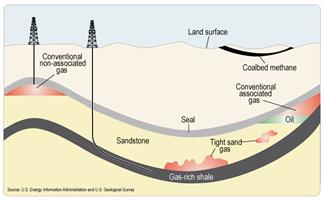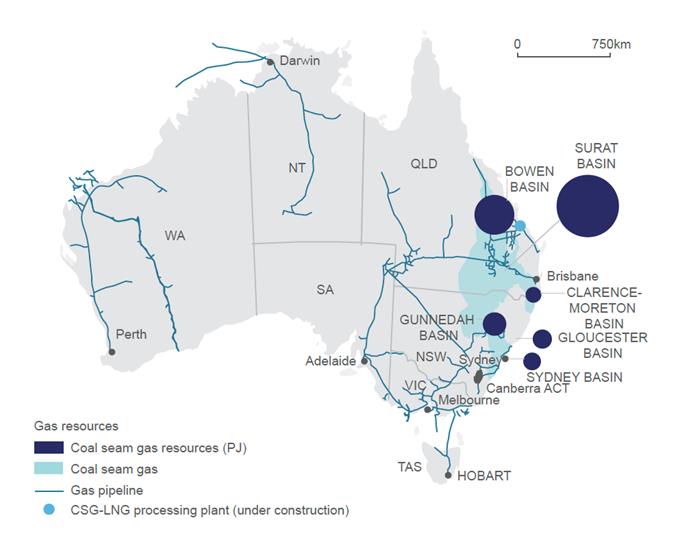Rowan Drinkwater,
Science, Technology, Environment and Resources
Key Issue
The development of coal seam gas (CSG) and exploration for other unconventional gas sources has been highly controversial. This controversy is focussed mainly on environmental impacts and land access issues. This brief outlines some of the key terms and concepts underlying the debate.
What is unconventional gas?
Natural
gas is combustible gas that is formed and held in underground deposits.
This gas is composed mainly of methane—up to 98 per cent—with varying amounts
of other trace gases depending on how and where it is formed. Some sources of
natural gas are called ‘unconventional’ because they are more difficult to
extract and require additional technology or effort beyond that required for more
‘conventional’
gas.
The different types of unconventional gas, and the
naming conventions, vary depending on their geological origin.
There are three main types. CSG—or
coalbed methane—is found in shallow coal seams. Tight gas is found in sandstone
layers that are not sufficiently porous—or too ‘tight’—for the gas to flow
through and hence trap the gas. Shale
gas is found in shale layers (see Figure 1).
Unconventional gas production, almost exclusively
from CSG, from 2011–12 accounted for about 13 per cent of all gas production in
Australia.
Figure 1: The geology of natural gas
resources

Source: US Energy
Information Administration website
Australia’s main CSG projects are located in Queensland
and New
South Wales (see Figure 2). There are also significant
potential volumes of shale and tight gas, across all
states and territories except the ACT, with the largest basins located in
Western Australia, the Northern Territory and in the Cooper Basin, which straddles
Queensland and South Australia. States and territories are all at different
stages in developing their regulatory frameworks for shale and tight gas, but
these industries are still emerging, with preliminary exploration currently
underway.
How is it different to conventional gas?
From a consumer perspective unconventional gas may
seem practically identical to conventional sources of natural gas, but there
are a few important differences.
Most sources of conventional gas are located
offshore, while many onshore sources are not located near other land users and
local communities. In contrast, CSG developments are often close to, or even
co-located with other industries, such as agriculture. In addition CSG
developments can be located close to regional towns and cities.
Figure 2: Australia’s coal seam gas
reserves—in petajoules (PJ)—and associated infrastructure

Source:
Office of the Chief Economist, Review of the socioeconomic impacts
of coal seam gas in Queensland 2015
Co-location at times has resulted in conflict
between landowners and resource interests.
In addition, the extraction of unconventional gas typically
requires more wells and more access roads and pipelines. This means more land
is needed than for conventional gas developments. Significant volumes of water
are also produced through the CSG extraction process. This water contains salts
and other contaminants that need to be treated at the surface and used or
disposed of appropriately.
For shale and tight gas, hydraulic fracturing
is usually required to enable gas production. Hydraulic fracturing is a process
where fluid and sand is injected at high pressure in order to re-open natural
fractures and create pathways for gas to flow.
Hydraulic fracturing, or ‘fracking’, has become
synonymous with CSG production. However, this is somewhat of a misnomer, as fracking
is not always used in CSG production in Australia. Of all the CSG wells in
Australia, fewer than 10 per
cent have been hydraulically fractured, but this number may increase over
time. Hydraulic fracturing also requires significant volumes of fresh water—typically
in quite dry areas—which can present its own challenges and risks.
Consequently, these projects can often be more
complex and costly than conventional gas ventures.
Why were these resources developed?
In Queensland, gas production from the two main CSG
basins—Bowen
and Surat—began
in 1998 and 2005 respectively. Production from these sources began in part as a
result of the reduction of conventional gas production from existing fields.
The production also coincided with a Queensland
government policy in place at the time that required up
to fifteen per cent of electricity to be sourced from gas-fired generation.
This policy, in part designed to reduce the state’s greenhouse gas emissions, also
helped create a fixed gas demand in the initial stages of development. Later
expansion of the CSG industry has been due primarily to the Liquefied Natural
Gas (LNG) export market. The high export value of LNG also precipitated the
exploration of shale gas resources in other states.
Risks and concerns
There have been a number
of concerns raised about the risks of unconventional gas development
including: human and environmental health impacts, threats to water resources,
air quality concerns, land use competition and social impacts.
Comparing the impacts observed in Australia with
overseas industries is challenging because of the influence of local conditions
on the potential risks. However, issues around well integrity, environmental
and human health risks as well as more general concerns have been found to be
similar.
The scarcity of baseline environmental data has also
hindered efforts to understand the potential impacts of CSG developments and
establish causal links between certain activities and observed impacts. Research
into these impacts and their management is continuing.
The water trigger and the IESC
The regulation of onshore gas resources is primarily
the responsibility of states and territories. However, in 2013, the Australian
Government amended the Environment Protection and Biodiversity Conservation
Act 1999 to require CSG and large coal mining developments to obtain
Commonwealth approval where they would have a ‘significant impact’ on water
resources. This is known as the ‘water
trigger’.
This Commonwealth approval is separate to state
approvals and must take into account advice from the Independent Expert Scientific
Committee on Coal Seam Gas and Large Coal Mining Development (IESC). Future
shale gas or tight gas projects in Australia will not be regulated under this
trigger as it only applies to CSG and large coal mining developments. The water
trigger is currently under review.
The review report was due to the Minister for the Environment by 31 March 2016.
Further reading
M O’Kane, Final Report of the Independent Review of Coal Seam Gas Activities in NSW, New South Wales Chief Scientist and Engineer, Sydney, September 2014.
Department of Industry, Innovation and Science, Energy in Australia 2015, Canberra, January 2016.
Select Committee on Unconventional Gas Mining, Interim Report, Canberra, 4 May 2016.
R Drinkwater, ‘
Coal Seam Gas: the Commonwealth's regulatory role’, FlagPost, Parliamentary Library blog, 13 July 2016.
Back to Parliamentary Library Briefing Book
For copyright reasons some linked items are only available to members of Parliament.
© Commonwealth of Australia

Creative Commons
With the exception of the Commonwealth Coat of Arms, and to the extent that copyright subsists in a third party, this publication, its logo and front page design are licensed under a Creative Commons Attribution-NonCommercial-NoDerivs 3.0 Australia licence.